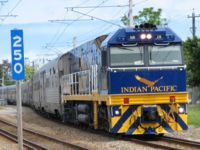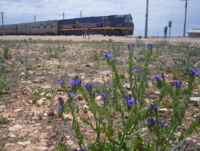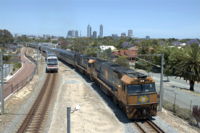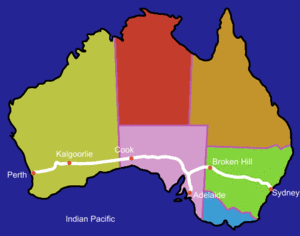Indian Pacific

The Indian Pacific is a passenger rail service running between Perth and Sydney, Australia. It was started in 1970 after the railway line between Sydney and Perth had all been converted to standard gauge. It covers 4352 kilometres, passes through three states and travels along the world's longest straight stretch of railway track. The journey takes about four days.
Contents
Route
The route leaves East Perth Station and travels east to Kalgoorlie. This section was built as narrow gauge, and even when it was converted to standard gauge in 1968 there was a change of locomotives and train crew at Kalgoorlie, from Westrail to Australian National Railways.
From there it continues east across the Nullarbor Plain on the Trans-Australian Railway to Port Augusta. This railway was built as standard gauge, completed in 1917 as part of the promises made to Western Australia on federation in 1901. The section includes the longest straight stretch of railway track in the world (478 km) around Cook. When it was built, there was a break-of-gauge at both ends.
The train continues south to Port Pirie, then inland to Crystal Brook, and south to Adelaide, the capital of South Australia. It returns along the same track to Crystal Brook, then turns east again towards Broken Hill, passing through the historic triple-gauge railway towns of Gladstone and Peterborough. Port Pirie to Broken Hill was rebuilt to standard gauge in 1970 (previously narrow gauge), and the Crystal Brook to Adelaide section was built in 1982. Prior to that the Indian Pacific did not go down to Adelaide, passengers transferring at Port Pirie from a broad-gauge Adelaide train.
From Broken Hill, the train continues across New South Wales to Parkes, then climbs over the Blue Mountains and into Sydney. It terminates at platform 1 at Central station.
In 2005, the train spends about three hours at Broken Hill, Adelaide and Kalgoorlie, and about one hour at Cook. During this time passengers may look around, and there are some optional tours.
Passenger facilities
Great Southern Railway has branded its services as Gold Kangaroo and Red Kangaroo. The former, the first-class service, features a choice of Roomette or Twinette sleeper cabins, with complimentary table d'hôte meals in the restaurant car. Drinks are available for purchase in the lounge car.
Red Kangaroo service, the equivalent of economy class, features a choice of airline-style seats (referred to as "sit-ups") in the coach cars or dual-berth shared sleeper cabins. It offers a buffet-restaurant car and a lounge bar.
The train also carries passengers' motor vehicles.
Typical consist
The following is the Indian Pacific consist as it arrived in Perth on the morning of Saturday, 28 January 2006. It is a typical consist, except for the inclusion of two "Special carriages", which are added on demand. During peak season, the train may be increased to a double consist.
- NR82 - Pacific National NR class locomotive
- HGM903N - brake, power and luggage van
- HM256 - luggage and mail van
- AG375W - first class passenger car
- AG376X - first class passenger car
- AFC939G - first class lounge car
- CDF924G - second class club and cafeteria car "Matilda's Restaurant"
- BRJ918E - second class twinette sleeping car
- ARJ941K - first class roomette sleeping car
- ARM953W - first class deluxe twinette sleeping car
- DF304E - first class dining car "Queen Adelaide Restaurant"
- AFC301G - second class twinette sleeping car "Flinders Lounge"
- ARL920Y - first class twinette sleeping car
- ARL962S - first class twinette sleeping car
- ARL310K - first class twinette sleeping car
- SSA260H - Special Service Car "The Chairman's Carriage"
- BMC1 - "Sir Hans Heysen" special carriage
- ER906U - crew dormitory car
- HGM900 - brake, power and luggage van
- AMRZ272U - double-deck car carrier, with 8 cars
- AMRZ2590F - double-deck car carrier, with 7 cars, 1 motorbike
- AMRZ268U - double-deck car carrier, with 8 cars
Christmas train

In recent years, the Indian Pacific has operated a Christmas Train with a notable music personality onboard.
The train stops at several locations to entertain the locals and thank them for their support of the train.
The locations include the remote Nullarbor sidings of Watson, Cook, and Rawlinna.
Some of the performers onboard have been Human Nature (2006), Guy Sebastian (2005), Jimmy Barnes (2004), John Paul Young (2003), Marcia Hines (2002), John Williamson (2001) & Nikki Webster (2000).
Incidents
On 24 December 1975 14 of the 25 carriages on the eastbound train derailed due to a collapsed bogie on the leading carriage, between the remote Nullarbor sidings of Haig and Nurina. Three of the 200 passengers were injured, and they were flown from Forrest to Adelaide. [1]
On 18 August 1999 the westbound train was accidentally directed into a crossing loop occupied by an eastbound train at Zanthus. Further information: Zanthus train collision.
On December 3 1999 a Cityrail interurban train ran into the back of the eastbound train at Glenbrook in the Blue Mountains, west of Sydney. Seven people died, all on the Cityrail train. Further information: Glenbrook train disaster.
External links
| Wikimedia Commons has media related to: Indian Pacific |
- Great Southern Railway
- Trans Australian/Indian Pacific railway ephemera—collected and digitised by the National Library of Australia




